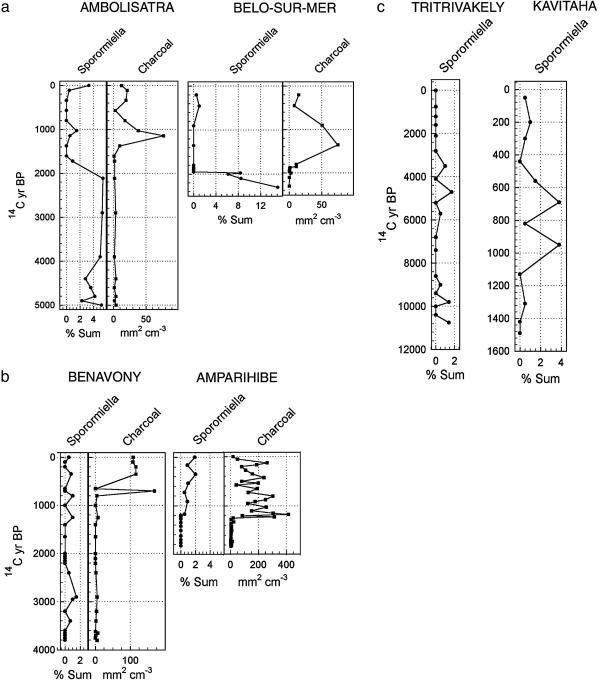Fig. 3.
Sporormiella spore and charcoal particle analyses for six sites throughout Madagascar. Spores are expressed as percent of pollen sum + Sporormiella, and charcoal is expressed as projected area in slides per volume of sediment. (a) Coastal sites in the arid southwest show very high percentages of Sporormiella before human arrival approximately two millennia ago. Late Holocene sediments are devoid of charcoal before human arrival and for approximately two centuries after Sporormiella decline. From ≈1,720 yr B.P. to a few centuries ago, Sporormiella is absent, and charcoal reaches an initial peak and then declines. Both Sporormiella and charcoal increase in recent centuries. (b) Humid sites of the northwest, Benavony marsh on the Sambirano River and Amparihibe crater lake on the shelf island of Nosy Be, provide information on low-elevation rain-forest sites. Benavony shows low to moderate values for Sporormiella in the late Holocene before an inferred human presence. The spore is absent there and also at Amparihibe, beginning approximately two millennia ago, until 1,130 yr B.P. when a moderate Sporormiella signal may correspond to the introduction of cattle husbandry. Charcoal increases simultaneously with this spore increase at Amparihibe and several centuries later in the dense rainforest of the interior at Benavony. (c) Sporormiella results from two central highland sites show that low to moderate spore values were recorded at the Tritrivakely crater lake throughout the prehuman Holocene. At the lower and less remote site of a volcanic barrier lake at Kavitaha in the central highlands, a core spanning the last 1,500 yr shows Sporormiella increasing to moderate percentages beginning ≈960 yr B.P. Charcoal particles (data not shown; see ref. 20) increase above moderate background levels approximately four centuries earlier. See Table 1 for key 14C details and calibrations.

